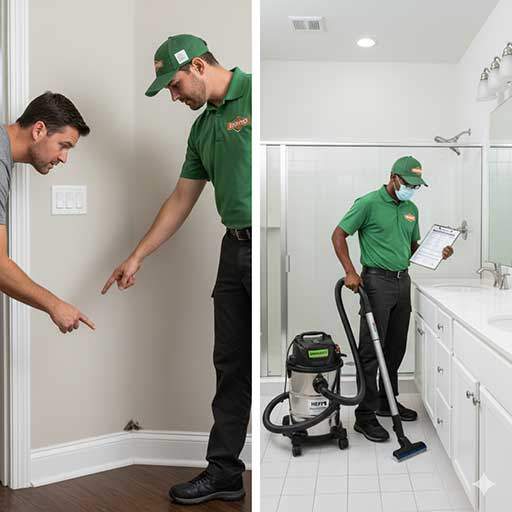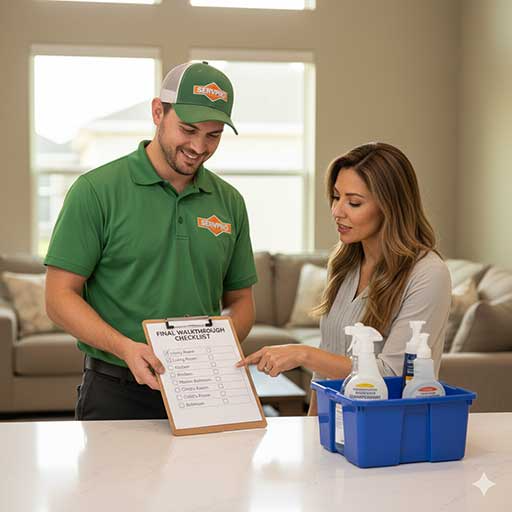Why “Personal House Cleaner” Often Isn’t Enough
A solo cleaner can make surfaces look tidy, but deeper issues remain: bacteria on high-touch points, trapped odors in fabrics, and fine dust in vents. Certified teams arrive with a documented scope, PPE when needed, and EPA-registered solutions. Instead of “two hours of general cleaning,” you get a repeatable protocol that covers kitchens, baths, bedrooms, fabrics, and air handling — the parts you can’t see but definitely breathe.
What Certified Teams Do Differently
- Checklist by area, not minutes. Results are defined upfront; no “ran out of time” surprises.
- Tools that matter. HEPA vacuums, air scrubbers, deodorization, steam or hot-water extraction (when applicable).
- CDC/EPA-aligned disinfection. Touch-point focus (handles, controls, faucets, railings).
- Documentation. Before/after photos or logs upon request — useful for landlords, insurance, and rentals.

Families, Kids, Pets: Clean without the Guesswork
Households with babies or pets need low-odor, residue-aware workflows. Certified crews can:
- Use hypoallergenic or low-VOC products where appropriate.
- Rinse or neutralize surfaces to avoid sticky, dust-catching films.
- Deodorize fabrics without masking scents.
- Offer optional air filtration runs (helpful after colds or seasonal allergies).
Outcome: floors safe for crawling kids, fabrics that don’t smell “chemical,” and kitchens ready for food prep right away.
Seniors at Home: Safety-First Cleaning
Senior living spaces benefit from targeted protocols:
- Slip-risk mitigation (dry, non-slick finishes in baths and kitchens).
- Low-odor products and improved ventilation during cleaning.
- High-touch coverage (bed rails, remotes, switches, grab bars).
- Post-hospital refresh to reduce contamination risk.
This is not “extra” — it’s baseline for a home that supports mobility and recovery.
Move-In / Move-Out & Post-Renovation: Beyond a Mop
Renovation dust behaves like smoke: it settles everywhere. Certified teams handle what solo cleaners usually can’t:
- HEPA capture of drywall and sanding dust (floors, trims, vents).
- Adhesive/paint residue removal on hard surfaces.
- Cabinet & appliance interiors (construction debris gets inside).
- Optional HVAC return cleaning and filter changes.
Result: you’re moving into a space that’s actually reset — not just swept.
Comparison: Personal Cleaner vs. Certified Cleaning Team
|
|
|
|
|
|
|
|
|
|
|
|
|
|
|
|
|
|
|
|
|
|
|
|
|
|
|
|
|
|
|
|
Quick Selector: Situation → Recommended Service
|
|
|
|
|
|
|
|
|
|
|
|
|
|
|
|
|
|
|
|
|
|
|
|
|
|
|
|
How a Certified Visit Typically Works
- Brief intake: rooms, sensitivities (kids/pets), and specific issues (odors, stains, dust).
- Walkthrough & scope: technician maps areas, confirms outcomes, sets expectations.
- Staging: protectants on corners, airflow set, equipment staged to avoid re-soiling.
- Cleaning & disinfection: by zone — kitchen, baths, living, bedrooms, entry.
- Proof & reset: spot checks, optional photos, disposal, ventilation restore, final sign-off.
What you do: nothing. No micromanaging, no “could you just…”. You get the outcome you booked.

Pricing & Expectations (Without the Fine Print)
- Outcome-based quotes beat hourly guessing. Ask for a scope tied to rooms and results.
- Add-ons you might actually need: fabric deodorization, inside appliances, vent returns.
- Schedule smart: post-renovation and move-in slots fill quickly; book dates early.
- Tell them upfront: kid/pet sensitivities, asthma, fragrance preferences — they can adapt.
When a Solo Cleaner Is Perfectly Fine
Balance & credibility
If your home is maintained weekly, no recent illness or construction, and you just want basic tidying, a solo personal house cleaner can be great. But for resets, odors, dust, health concerns, or tight deadlines, a certified team is a safer, faster bet — and often more cost-effective once you count re-cleans and wasted weekends.
Wrap-Up
You wanted “clean.” What you actually need is clean, safe, and done right. A personal house cleaner can cover light maintenance, but certified teams bring protocols, equipment, and accountability that make a home truly livable — for families, seniors, guests, and you.